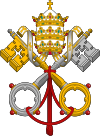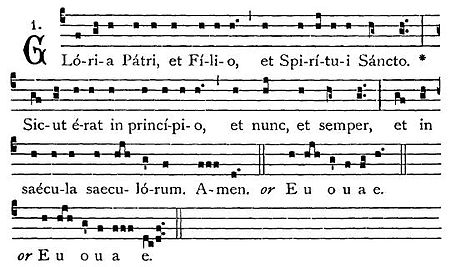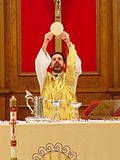- Gloria Patri
-
'Gloria Patri, also known as Glory Be to the Father’ (or, colloquially, the “Glory Be”), is a doxology, a short hymn of praise to God in various Christian liturgies. It is also referred to as the Minor Doxology (Doxologia Minor) or Lesser Doxology, to distinguish it from the Greater Doxology, the Gloria in Excelsis Deo.
Contents
Greek version
The Greek wording is as follows:
- Δόξα Πατρὶ καὶ Υἱῷ καὶ Ἁγίῳ Πνεύματι,
- καὶ νῦν καὶ ἀεὶ καὶ εἰς τοὺς αἰῶνας τῶν αἰώνων. Ἀμήν.
- Glory to the Father, and to the Son, and to the Holy Spirit,
- Both now and always, and unto the ages of ages. Amen.
The earliest forms of the first part of this Trinitarian doxology are addressed to the Father through (διά) the Son and in (ἐν) or with (μετά) the Holy Spirit, but in the fourth century the custom of using and (καί) became universal among Catholics in reaction to Arian use of the prepositions to suggest subordinationism.[1] In Greek, the second part became[1] that given above, which is used by the Eastern Orthodox Churches (and the Eastern Catholic Churches of Byzantine Rite) and by the Oriental Orthodox Churches.
Syrian version
- Shouha tababa, W-brona, W-ruha dqudsha,
- min’alam w’adamma L-’alam, Amen.[2]
- Glory be to the Father and to the Son and to the Holy Spirit,
- from everlasting and for ever and ever (one translation)[3]
- OR
- forever and ever. Amen (another translation).[4][5]
According to Worship Music: A Concise Dictionary, the lesser doxology is of Syrian origin.[6]
This form, as the cited sources show, is used by the Assyrian Church of the East and the Chaldean Catholic Church.
Roman Rite Latin version
Pronunciation of the Glory Be to the Father (Gloria patri) in Latin with a strong American English accent.
- Gloria Patri, et Filio, et Spiritui Sancto,
- Sicut erat in principio, et nunc, et semper, et in saecula saeculorum. Amen.
- Glory to the Father, and to the Son, and to the Holy Spirit,
- As it was in the beginning, also now, and always, and to ages of ages. Amen.
In 529 the Second Synod of Vasio in Gaul (modern (Vaison) said in its fifth canon that the second part of the doxology, with the words Sicut erat in principio, was used in Rome, the East, and Africa, and ordered it to be said likewise in Gaul.[1] Writing in the 1909 Catholic Encyclopedia, Adrian Fortescue, while remarking that what the synod said of the East was false, took the synod's decree to mean that the form originally used in the West was the same as the Greek form.[1] From about the seventh century the present Roman Rite version became almost universal throughout the West.[1]
Mozarabic Rite Latin version
-
- Gloria et honor Patri et Filio et Spiritui sancto
- in saecula saeculorum.[1]
-
- Glory and honour to the Father and to the Son and to the Holy Spirit
- for ages of ages.
The similarity between this version used in the then extreme west of the church and the Syrian version used in the extreme east is noteworthy.
English version
This doxology in the Anglican Churches is most commonly found in the following traditional form:
- Glory be to the Father, and to the Son :
- and to the Holy Ghost;
- As it was in the beginning, is now, and ever shall be :
- world without end. Amen.
The translations of semper as ever shall be, and in saecula saeculorum as world without end date from Cranmer's Book of Common Prayer, and are most commonly found in Anglican usage, as well as the derivative usage of older Lutheran liturgical books.
In the contemporary usage of the Roman Catholic, Anglican, and Lutheran churches, the following translation by the International Consultation on English Texts (ICET) has been widely used since 1971:
- Glory to the Father, and to the Son, and to the Holy Spirit:
- as it was in the beginning, is now, and will be for ever. Amen.
This is the version found in the Roman Catholic Liturgy of the Hours[7] used, for instance, in the United States, while the corresponding Divine Office[8] used, for instance, in Australia, England and Wales, and Ireland has:
- Glory to the Father, and to the Son, and to the Holy Spirit.
- As it was in the beginning, is now, and ever shall be, world without end. Amen.
More recent Anglican usage has introduced a further variant (found in Common Worship):
- Glory to the Father and to the Son
- and to the Holy Spirit;
- as it was in the beginning is now
- and shall be for ever. Amen.
Especially in Anglican circles there are various alternative forms of the Gloria designed to avoid masculine language. The form included in Common Worship is:
- Glory to God, Source of all being,
- Eternal Word and Holy Spirit;
- as it was in the beginning is now
- and shall be for ever. Amen.
The doxology has a different translation in the use of the English-speaking Orthodox and Greek-Catholic Churches, as following:
- Glory to the Father and the Son and the Holy Spirit,
- now and forever and to the ages of ages. Amen.
Use
In the Eastern Orthodox Churches, the Oriental Orthodox Churches, the Assyrian Church of the East and the Eastern Catholic Churches, the Lesser Doxology is frequently used at diverse points in services and private prayers. Among other instances, it is said three times by the reader during the usual beginning of every service, and as part of the dismissal at the end. When it is used in a series of hymns it is chanted either before the last hymn or before the penultimate hymn. In the latter case, it is divided in half, the "Glory..." being chanted before the penultimate hymn, and "Both now..." being chanted before the final hymn (which is usually a Theotokion).
In the Roman Rite, the Gloria Patri is frequently chanted or recited in the Liturgy of the Hours or Divine Office (prayed by the clergy, many religious orders and congregations, and, more frequently since Vatican II, by laity as well), principally at the end of psalms and canticles and in the responsories. It also figures in the Introit of the pre-1970 form of Mass in the Roman Rite. The prayer figures prominently in non-liturgical devotions, notably the rosary, where "Glory be" is recited before the large beads (on which an "Our Father" is prayed) which separate the five sets of ten smaller beads, called decades, upon each of which a Hail Mary is prayed.
Amongst Anglicans, the Gloria Patri is mainly used to conclude the singing or recitation of psalms and canticles at the Daily Offices of Morning and Evening Prayer.
Lutherans have historically added the Gloria Patri both after the chanting of the Responsorial Psalm and following the Nunc Dimittis during their Divine Service, as well as during Matins and Vespers in the Canonical hours. The Gloria Patri is also frequently used in evangelical Presbyterian churches. In Methodism, the Gloria Patri (usually in the traditional English form above) is frequently sung to conclude the "responsive reading" that takes the place of the Office Psalmody.
Media
See also
- Greater doxology
References
- ^ a b c d e f Catholic Encyclopedia, Doxology
- ^ Chaldean Neo-Aramaic
- ^ The Hallowing of Addai and Mari
- ^ The Chaldean Church
- ^ Chaldean Rite
- ^ Edward Foley, Mark Paul Bangert, Worship Music: A Concise Dictionary (Liturgical Press 2000 ISBN 0-8146-5889-X), p. 126
- ^ Catholic Book Publishing Company)
- ^ Collins (London, Glasgow), Dwyer (Sydney), Talbot (Dublin)
 This article incorporates text from a publication now in the public domain: Herbermann, Charles, ed (1913). Catholic Encyclopedia. Robert Appleton Company.
This article incorporates text from a publication now in the public domain: Herbermann, Charles, ed (1913). Catholic Encyclopedia. Robert Appleton Company.
External links
- "Doxology" at New Advent
- Glory Be
- The Glory Be and other prayers of the Rosary in many languages
- A website with the Lord's Prayer in multiple languages; some of the languages also have the Glory Be
Prayers and the Catholic Church Prayers of the Mass Agnus Dei · Apostles' Creed · Confiteor · Gloria in excelsis Deo · Gloria Patri · Kyrie Eleison · Litany of the Saints · Nicene Creed · Pater Noster · Sanctus · Signum Crucis

Marian prayers Other prayers Act of Contrition · Adoro te devote · Angele Dei · Anima Christi · Athanasian Creed · Ave Verum Corpus · Benedictus · De Profundis · Jesus Prayer · Laudes Divinae · Miserere mei · Morning offering · Nunc Dimittis · O Salutaris Hostia · Prayer before a Crucifix · Prayer of Saint Francis · Prayer to Saint Michael · Requiem Aeternam · Spiritual Communion · Tantum Ergo · Te Deum · Thanksgiving after Communion · Veni Creator Spiritus · Veni Sancte Spiritus · Visit to the Blessed Sacrament · Way of the Cross
Categories:- Christian prayer
- Eastern Christian liturgy
- Catholic liturgy
- Lutheran liturgy and worship
- Rosary
Wikimedia Foundation. 2010.


